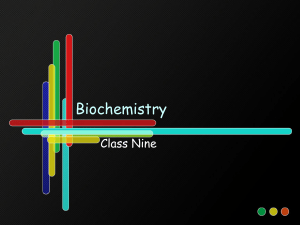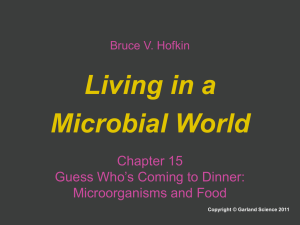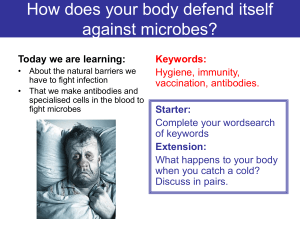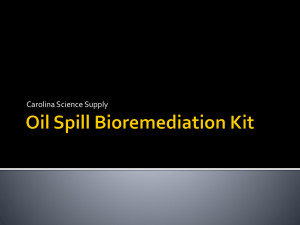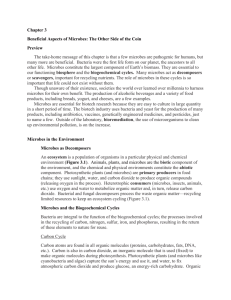Microbes In Human Welfare
advertisement
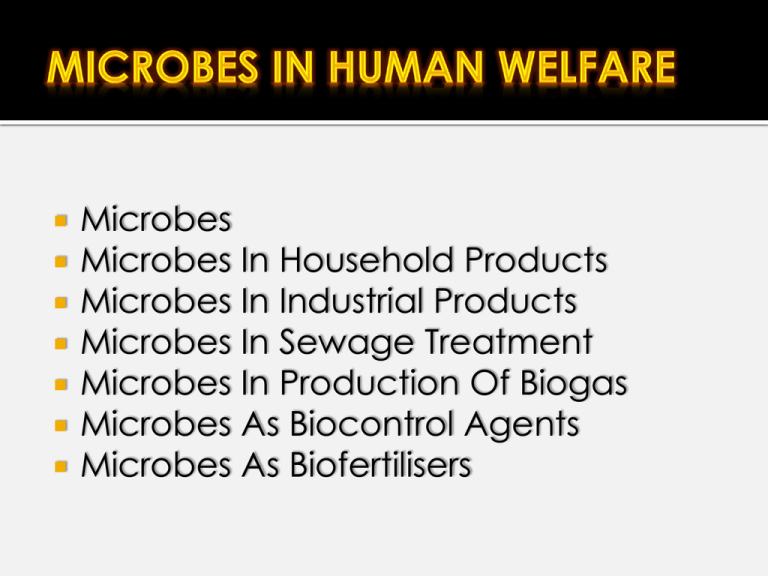
Microbes Microbes In Household Products Microbes In Industrial Products Microbes In Sewage Treatment Microbes In Production Of Biogas Microbes As Biocontrol Agents Microbes As Biofertilisers 1. Microbes are microscopic organisms (invisible to naked eye) 2. They are present everywhere on earth- in soil, water, air, in our bodies, plants and even at the most extreme locations such as hot water geysers and poles. 3. Microbes are diverse, they can be- protozoa, bacteria, fungi, viruses, viroids, prions etc. 4. Microbes are thought to be the main disease causing agents, but they can be helpful to human beings in many ways. We will see how in subsequent slides. Escherichia coli Lactobacillus Methanobactarium Azatobacter 1. Production of curd from milk a. Microbes such as Lactobacillus and a group called Lactic Acid Bacteria(LAB) convert milk to curd by producing acids which partially digest and coagulate milk proteins. b. A small amount of curd (starter or inoculum) which is added to milk contains millions of bacteria which multiply under suitable conditions and thus converting it to curd. c. This process increases the nutritional value of milk by increasing vitamin B12 , it also checks disease causing organisms in our stomach. 2. Fermentation a. The fermentation of dough is due to bacteria and its puffed appearance is due to the production of CO2 during fermentation. b. Toddy, an alcoholic drink is made from Fermentation of palm sap. c. A yeast, Saccharomyces cerevisiae (baker's yeast) is used for fermenting bread dough. d. Cheese is also a product of fermentation and/or ripening, and different varieties of cheese are due to different microbes used for fermenting. e. The holes in cheese are due to large CO2 production by the bacteria. Saccharomyces cerevisiae as seen under DIC (Differential Interference Contrast) microscope. The large holes in Swiss cheese are due to huge amount of CO2 released during fermentation by Propionibacterium shermanii 1. Beverages 2. Antibiotics 3. Organic acids 4. Enzymes 5. Bio-active molecules 1. Beverages a. When juices and malted cereals are fermented they get converted to ethanol. b. Brewer's yeast (Saccharomyces cerevisiae) is commonly used for fermentation. c. Drinks with versatile colour and flavour are produced depending upon the raw material and nature of processing used d. Classification of beverages (i) Whisky, Rum and Brandy are distilled beverages. (ii) Wine and beer are not distilled. 2. Antibiotics a.The term means 'against life' with reference to disease causing organisms. b. The first antibiotic penicillin was discovered by Alexander Fleming. c. Penicillin is obtained from a fungus Penicillium notatum. d. These are used in treatment of a number of diseases such as, diptheria, leprosy, whooping cough, plague etc. 3. Organic acids a. Various organic acids are produced with the help of microbes. The below lists the organic acids and name of the microbe employed in producing itOrganic Acids Microbe 1. Citric Acid 1. Aspergillus niger (fungus) 2. Acetic Acid 2. Acetobacter aceti (bacterium) 3. Butyric acid 3. Clostridium butylicum (bacterium) 4. Lactic Acid 4. Lactobacillus (bacterium) 5. Ethanol 5. Saccharomyces cerevisie (yeast) 4. Enzymes produced with the help of microbes arei.Lipases (lipid dissolving, produced by Candida lipolytica) ii. Proteases iii. Pectinase a. Lipases are added in detergents for removing oily stains b. Pectinases and proteases are used to clear fruit juices during bottling. c. Streptokinase is produced by Streptococcus. It is modified by genetic engineering and used as 'clot buster‘ for dissolving blood clots of patients after myocardial infarction. 5. Bioactive molecules a. Cyclosporin A i. A fungus Trichoderma Polysporum produces it. ii. It has immuno suppresive properties so it is used as an immuno- supressive agent during organ transplantation. b. Statins i. These are the products of fermentation activity of yeast, Monascus purpureus. ii. It inhibits cholesterol synthesis, so used for lowering blood cholesterol level. Beer, a product of fermentation Antibiotics Acetic acid, the main component of Vineger Cholesterol lowering tablets(statins) Need for sewage treatment- 1. The municipal waste water(sewage) contains large amount of organic waste and microbes. 2. This can invite diseases and epidemic when this water meets community water bodies like lake pond and rivers. 3. To check this the sewage is made less polluting by passing it through sewage treatment plants(STPs) This involves two steps i. Primary Treatment ii. Secondary Treatment 1. Primary treatment a. It is a physical process, it uses sedimentation and filtration to filter small and large particles. b. First the sewage is passed through mesh screens of small pore sizes to remove floating objects like polythene. c. The grit is removed by sedimentation by passing sewage into grit chamber. d. Then it is kept in settling tanks, where the suspended materials settle down to form the primary sludge. e. The remaining fluid is taken for secondary treatment. 2. Secondary treatment a. It is a biological process by heterotrophic bacteria present in the sewage. b. The primary effluent is aerated in aeration tanks. c. This causes rapid growth of aerobic bacteria, which then as 'flocs' consume the organic matter to reduce the Biochemical Oxygen Demand (BOD). d. After this the effluent is passed to settling tanks where these 'flocs' get sedimented. (Activated Sludge). e. A part of this sludge is pumped back to aeration tanks for further use. f. This sludge is pumped to anaerobic sludge digesters, where anaerobic bacteria form gases like methane CO2 and H2S. g. After this the effluent is released into water bodies like streams and rivers. Microorganisms In Sewage Treatment 1. Biogas a. Biogas consists of methane(60%) and CO2(40%) b. Produced by Methanobacterium by acting on cellulosic compounds, these are found in rumen of cattle and anaerobic sludge of sewage. c. Cattle dung contains both cellulosic as well as methanogens so it's used for biogas production. d. It is a popular method for meeting energy requirements of rural households, and also helps in reducing precious firewood. 2. The steps involved in the production of biogas- a. The biogas plant consists of a 10-15 feet deep concrete tank in which the slurry of dung is fed. b. A floating cover is kept over the slurry which keeps on rising as the gas is produced in the tank by microbial activity. c. An outlet connected to a pipe is present in the biogas plant for the removal of biogas and supplying it to required places. d. The spent slurry is removed through another outlet which can be used as a fertiliser. A typical biogas plant. A biogas plant in Tamil Nadu. 1. Biological control is defined as the reduction of pest populations by natural enemies and typically involves an active human role. 2. For Example- a. The spores of Bacillus thuringiensis (Bt) are toxic to certain larvae, but not harmful for others. b. The fungus trichoderma is being used for fighting plant diseases. c. Baculoviruses are the pathogens used for attacking harmful insects and arthropods, they belong to genus Nucleopolyhedrovirus. 1. The use of biofertilsers instead of chemical ones has been known to keep the soils fertility intact for longer durations. They are organisms like bacteria, fungi and cyanobacteria, that enrich the soil. 2. a. Bacteria - Rhizobium, Azospirilium, Azatobacter fix atmospheric nitrogen and enrich nitrogen content of soil. b. Fungi -They form symbiotic relation with roots of plants eg. mycorrhiza. It absorbs phosphorous and passes it to plant, also it shows resistance to pathogens and salinity. c. Cyanobacteria - They are autotrophic microbes which can fix atmospheric nitrogen, for eg. Anabaena, Nostoc, Oscillatoria. They are important biofertilisers in paddy fileds.







